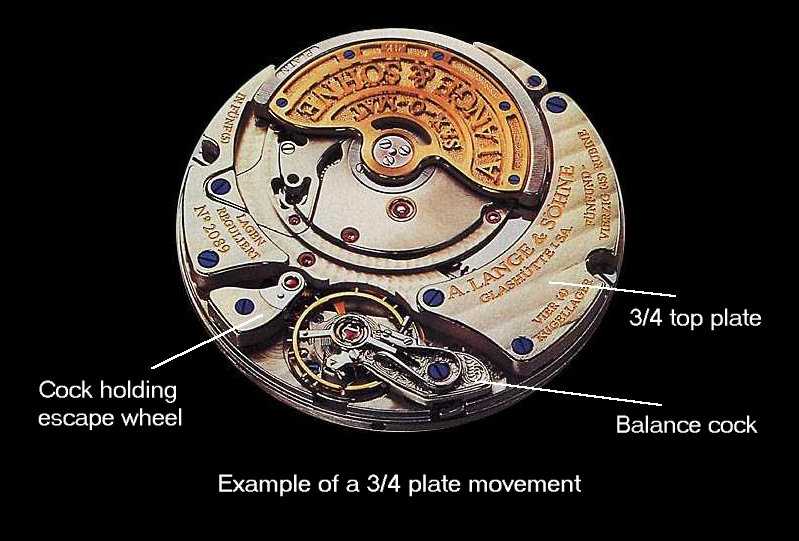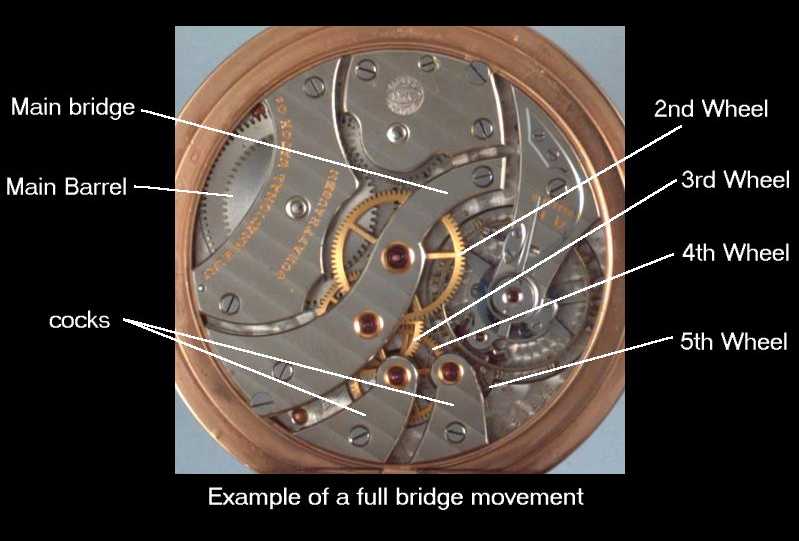
Note the balance cock is on a different plane from the rest of the train, which in the picture is hidden below the top plate. Note also, the top plate in this example, an Illinois 18 size Bunn Special, the top plate is split.
Typically movements can be catagorised by the top plate, viz:
Each of which is elaborated in some detail as follows:

| A full plate is featured in very old watches, pre 1850. The movement
comprises of a bottom plate, and a top plate separated by pillars. The
entire gear train is within these two plates. The balance wheel, cock is
usually driven via a verge...which connects the train to the balance which
goes on top of the top plate. Many of these watches are fusee driven,
especially English ones, though most other European prefer the stackfreed.
Note the balance cock is on a different plane from the rest of the train, which in the picture is hidden below the top plate. Note also, the top plate in this example, an Illinois 18 size Bunn Special, the top plate is split. |
| In a 3/4 plate arrangement, the top plate features a 1/4 cutout. This plate
usually holds the barrel and the winding wheel, the second (also known as
cannon) wheel, the third wheel and the fourth wheel. Only the balance wheel
held by a cock. (a cock is a bar secured to the bottom plate by one anchor,
whilst a bridge is a bar anchored in two or more places). Sometimes, the fourth wheel has its own cock.
The example on the left is a modern 3/4 plate movement of the Lange automatic movement. Note the micro-rotor. Note also, this is the classical arrangement, where there are only two cocks - one holding the escape wheel, and another the balance. Note also the lyre shaped pin holding the cap jewel of the balance arbor. This is the shock resist system. | 
|
In a 1/2 plate movement features 3 cocks...one for the balance, one for the
fifth wheel, and another for the fourth wheel (which drives the seconds
hand, either directly or indirectly). All the other gear train is held by
the 1/2 top plate. These can be sometimes very beautiful...with three
fingers below the half plate...

| In a full bridge movement, only the barrel and winding wheel are held by
the very small top plate. A bridge holds the second and third wheel, a cock
the fourth and another cock the fifth, and yet another the balance.
Sometimes, in a lepine caliber, the fourth is held by the main bridge.
Some variations to this theme is usually found in the way the barrel bridge is executed. Somtimes by a bar, sometimes by a plate-like bridge covering the entire barrel, and yet in others by stepped bars. This example is taken from a 1920s IWC lepine pocket watch. Note the location of the fourth wheel, which carries the seconds hands, is directly opposite the winding barrel (which attached to the crown (not visible)...indicating a subsidiary seconds hand at 6 o'clock and inline with the crown = lepine caliber. |

And accessed
times since.